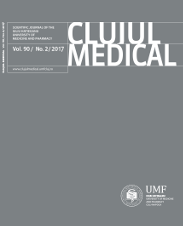Flap Surgical Techniques For Incisional Hernias Reccurences. A Swine Experimental Model
DOI:
https://doi.org/10.15386/cjmed-684Keywords:
incisional hernia, surgical flaps, recurrence, harvesting techniques, complications, swine modelAbstract
Background and aims. In the age of synthetic prostheses most of hernia studies include a careful examination of the various types of prosthesis, their characteristics and their repair indications. Biological prostheses are also beginning to draw attention. But in terms of recurrence especially for poor or developing countries, the discussion is different, due to their high cost which makes them difficult to afford. In this article we present new flap reconstruction techniques for the reconstruction of the abdominal wall versus mesh repair, applied on swine models, outline the results of each technique, and specify the indications for their use.
Methods. An experimental protocol using four swine models (PIC-FII-337 hybrid breed pigs), five months old, was conducted. All animal care and operative procedures were studied following the protocol approved by the Ethics Committee of the University of Medicine and Pharmacy resolution no. 281/2014 of the Department of Surgery of the University of Agricultural Sciences and Veterinary Medicine); the study was carried out between November 2015 and February 2016. The primary objective was to compare the effect of surgical strategies in the treatment of the abdominal wall defect using variable flaps versus mesh repair in a large-animal models. Physical examination and ultrasound imaging of the abdominal wall repair were done on determined periods, during one month. The complications occurring after the abdominal wall repair were edema, collections, superficial dehiscence an recurrences.
Results. No recurrences were reported at one month results, all seromas reported were solved over time by natural drainage. Superficial necrosis appeared in two swine models and superficial dehiscence occurred in one model, the perforator ”plus” flap. Mesh infection was detected in the “onlay” swine model.
Conclusions. In terms of recurrences, contaminated abdominal wall defects or other contraindications to the use of prosthetic materials, biological mesh repair or flap surgery are the only surgical options. Based on our findings and considering the high cost reported by the biological meshes use, flap surgery becomes the suitable treatment for such cases, allowing a good reconstruction of the abdominal wall.
Downloads
Additional Files
Published
How to Cite
Issue
Section
License
The authors are required to transfer the copyright of the published paper to the journal. This is done by agreeing to sign the Copyright Assignment Form. Whenever the case, authors are also required to send permissions to reproduce material (such as illustrations) from the copyright holder.

The papers published in the journal are licensed under a Creative Commons Attribution-NonCommercial-NoDerivatives 4.0 International License.

